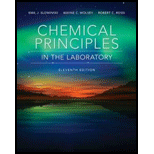
(a)
Interpretation:
To find the electrode where the oxidation is occurring.
Concept introduction:
Oxidation is the loss of electrons or an increase in the oxidation state of an atom, an ion, or of certain atom in a molecule.
Answer to Problem 1ASA
The oxidation occurs at zinc electrode, because the zinc electrode is negative.
Explanation of Solution
The negative electrode in a voltaic cell is taken to be the one from which electrons are emitted (i.e., where oxidation occurs). The negative electrode is the one that is connected to the minus pole of the voltmeter when the voltage is measured.
Therefore, the oxidation occurs at zinc electrode, because zinc electrode is negative.
(b)
Interpretation:
To write the equation for the oxidation half-reaction in the cell.
Concept introduction:
Half-reaction is defined as either the oxidation or reduction reaction of a
Answer to Problem 1ASA
The equation for the oxidation half-reaction is obtained.
Explanation of Solution
Hence, the equation for the oxidation half-reaction of this cell is written as
Therefore, the zinc electrode is considered as the oxidation half-reaction of this cell.
(c)
Interpretation:
To write the equation for the reduction half-reaction in the cell.
Concept introduction:
Half-reaction is defined as either the oxidation or reduction reaction of a redox reaction. A half-reaction is obtained by considering the change in the oxidation states of individual substances involved in the redox reaction.
Answer to Problem 1ASA
The equation for the reduction half-reaction is obtained.
Explanation of Solution
Chemical reactions can be classified as oxidation-reduction reactions, because they involve the oxidation of one species and the reduction of another. Such reactions can conveniently be considered as the result of two half-reactions, one of oxidation and the other reduction.
Hence, the equation for the reduction half-reaction of this cell is written as
Therefore, the copper electrode is considered as the reduction half-reaction of this cell.
(d)
Interpretation:
To write the net ionic equation for the spontaneous oxidation-reduction reaction that occurs in the cell.
Concept introduction:
The net ionic equation is obtained by combining both oxidation and reduction-half reactions in this cell.
Answer to Problem 1ASA
The net ionic for the spontaneous oxidation-reduction reaction is obtained.
Explanation of Solution
When we connect a voltmeter between the two electrodes, we will find that there is a voltage, or potential, between them. The magnitude of the potential is a direct measure of the chemical tendency, or more properly the
Hence, the net ionic for the spontaneous oxidation-reduction reaction that occurs in this cell is written as
Therefore, the oxidation and reduction reaction of zinc and copper electrode is considered as the net ionic equation of this cell.
Want to see more full solutions like this?
Chapter 32 Solutions
Chemical Principles in the Laboratory
- What is the final product when D-galactose reacts with hydroxylamine?arrow_forwardIndicate the formula of the product obtained by reacting methyl 5-chloro-5-oxopentanoate with 1 mole of 4-penten-1-ylmagnesium bromide.arrow_forwardIn the two chair conformations of glucose, the most stable is the one with all the OH groups in the equatorial position. Is this correct?arrow_forward
- please help me with my homeworkarrow_forwardhelparrow_forwardThe temperature on a sample of pure X held at 1.25 atm and -54. °C is increased until the sample boils. The temperature is then held constant and the pressure is decreased by 0.42 atm. On the phase diagram below draw a path that shows this set of changes. pressure (atm) 2 0 0 200 400 temperature (K) Xarrow_forward
- QUESTION: Answer Question 5: 'Calculating standard error of regression' STEP 1 by filling in all the empty green boxes *The values are all provided in the photo attached*arrow_forwardpressure (atm) 3 The pressure on a sample of pure X held at 47. °C and 0.88 atm is increased until the sample condenses. The pressure is then held constant and the temperature is decreased by 82. °C. On the phase diagram below draw a path that shows this set of changes. 0 0 200 temperature (K) 400 аarrow_forwarder your payment details | bar xb Home | bartleby x + aleksogi/x/isl.exe/1o u-lgNskr7j8P3jH-1Qs_pBanHhviTCeeBZbufuBYT0Hz7m7D3ZcW81NC1d8Kzb4srFik1OUFhKMUXzhGpw7k1 O States of Matter Sketching a described thermodynamic change on a phase diagram 0/5 The pressure on a sample of pure X held at 47. °C and 0.88 atm is increased until the sample condenses. The pressure is then held constant and the temperature is decreased by 82. °C. On the phase diagram below draw a path that shows this set of changes. pressure (atm) 1 3- 0- 0 200 Explanation Check temperature (K) 400 X Q Search L G 2025 McGraw Hill LLC. All Rights Reserved Terms of Use Privacy Cearrow_forward
 Chemistry: The Molecular ScienceChemistryISBN:9781285199047Author:John W. Moore, Conrad L. StanitskiPublisher:Cengage Learning
Chemistry: The Molecular ScienceChemistryISBN:9781285199047Author:John W. Moore, Conrad L. StanitskiPublisher:Cengage Learning Chemistry: Principles and PracticeChemistryISBN:9780534420123Author:Daniel L. Reger, Scott R. Goode, David W. Ball, Edward MercerPublisher:Cengage Learning
Chemistry: Principles and PracticeChemistryISBN:9780534420123Author:Daniel L. Reger, Scott R. Goode, David W. Ball, Edward MercerPublisher:Cengage Learning Principles of Modern ChemistryChemistryISBN:9781305079113Author:David W. Oxtoby, H. Pat Gillis, Laurie J. ButlerPublisher:Cengage Learning
Principles of Modern ChemistryChemistryISBN:9781305079113Author:David W. Oxtoby, H. Pat Gillis, Laurie J. ButlerPublisher:Cengage Learning ChemistryChemistryISBN:9781305957404Author:Steven S. Zumdahl, Susan A. Zumdahl, Donald J. DeCostePublisher:Cengage Learning
ChemistryChemistryISBN:9781305957404Author:Steven S. Zumdahl, Susan A. Zumdahl, Donald J. DeCostePublisher:Cengage Learning General Chemistry - Standalone book (MindTap Cour...ChemistryISBN:9781305580343Author:Steven D. Gammon, Ebbing, Darrell Ebbing, Steven D., Darrell; Gammon, Darrell Ebbing; Steven D. Gammon, Darrell D.; Gammon, Ebbing; Steven D. Gammon; DarrellPublisher:Cengage Learning
General Chemistry - Standalone book (MindTap Cour...ChemistryISBN:9781305580343Author:Steven D. Gammon, Ebbing, Darrell Ebbing, Steven D., Darrell; Gammon, Darrell Ebbing; Steven D. Gammon, Darrell D.; Gammon, Ebbing; Steven D. Gammon; DarrellPublisher:Cengage Learning





